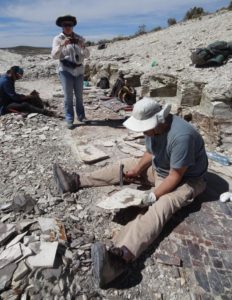 With 52 million years old, discover fossilized remains of the prehistoric tomatillo adds 30 million years to the time that had been presumed. The finding has been published in the prestigious journal Science.
With 52 million years old, discover fossilized remains of the prehistoric tomatillo adds 30 million years to the time that had been presumed. The finding has been published in the prestigious journal Science.
In the Laguna del Hunco, in Chubut, amid the Patagonia Argentina, does 52 million years grew a small plant inserted into a temperate forest. The small round fruit surrounded by delicate leaves the current tomatillo -parecido- It is the oldest relative found so far Tomato, potato, of pepper and snuff, among others 2.400 species of the same family that still exist.
Until now certain that the origin of the tomato was in South America had, in the Andean region, but it was not suspected that he might be in Patagonia. This finding means that at that time the region enjoyed tropical conditions which they made plants of this nature evolve in an appropriate context and clarifies the story about the origins of an emblematic plant in society.
Experts suggest that the berries fell into the lake and deposited at the bottom, and that lack of oxygen could preserve the organic waste. Here they met, for example, the first of Eucalyptus species in South America and Agarhis, belonging to the family of Araucaria.
 Dr. Ruben Cúneo, director Museo Egidio Feruglio (MEF) and researcher CONICET, He contextualized the finding: “Climatic conditions prevailing at that time in the northern Patagonia were tropical and subtropical; climates were much warmer, Antarctica was populated by all sorts of creatures and this finding is an additional example of how dynamic the climate and life around the planet over millions of years”.
Dr. Ruben Cúneo, director Museo Egidio Feruglio (MEF) and researcher CONICET, He contextualized the finding: “Climatic conditions prevailing at that time in the northern Patagonia were tropical and subtropical; climates were much warmer, Antarctica was populated by all sorts of creatures and this finding is an additional example of how dynamic the climate and life around the planet over millions of years”.
“It definitely is the oldest record of this family of tremendous economic importance today: 52 millions of years. In addition, since the characteristics of the fossil is identical to the genus Physalis living today, suggests that the morphological condition derived modern and had already appeared over 50 million years ago in Patagonia, which speaks of a tremendous initial diversification family”, said the expert.
The publication of the discovery of the millennial tomato has been performed by Dr. Peter Wilf, of the University of Pennsylvania; Drs Monica Carvalho and Alejandra Gandolfo, of the Cornell University and Cúneo own, who expressed his pride in being part of this team who led one of the most important paleontological discoveries of world history.
“It is amazing to find these specimens extremely rare fruit physalis. Only fossils are known throughout the nightshade family that preserve enough information to be identified as such“, explica Peter Wilf, academician of Geosciences at the University of Penn State, in United States, and coordinator of the study published in the journal Science.
[quote]This discovery delay 30 million plus the evolutionary clock Solanaceae.[/quote]
The team not only determined the age of fossils, but also the fact that this family was diversified much earlier than thought, before South America, Australia and Antarctica separated. Until now, only they had found fossils from tomatillos 9 and 11 million years ago, much later to this separation.
The tomatillo and all his relatives are a very important family worldwide. “Brought to Europe, They saved the economy of the area in the centuries XV and XVI”, Marcelo explains Leppe, section chief of the Chilean Antarctic Institute palaeobiology (Inach). Tomato and potato not only ended the famine, but also they allowed to feed the crews of ships, because they could be stored for longer times.
This adds to the important role that already had these crops in cultures of America. While all members of this great family are found throughout the continent, It is in Mexico where they reached their greatest diversity, says study. “They are an essential part of the human diet and in some cultures make up the 30% menu”, adds specialist. Added to that, its compounds are being investigated for medicinal purposes, as the anti-cancer quality of the substance that gives chili itching to.
SIX YEARS OF RESEARCH
Tomato baptized “Infinemundis”, what does it mean “End of the World”, It is part of the Solanaceae family and was found in 2011 Gastre area, northwest of Chubut, on a volcanic formation named by scientists as “Laguna del Hunco ", in Patagonia.
?? This place represents a real window to the past that has preserved over time an incredible diversity of plants, addition of small amphibians and fish ??, say from the Museum, after checking the significance of the news around the world.
according Cúneo, ?? This is a deposit that formed from a volcanic caldera, which it is then transformed into a lake. This lake was installed on a very rainy area, surrounded by an incredibly diverse forest. Then all traces (forest) that year after year produced, They fell into the lake and deposited at the bottom, where anoxic conditions (oxygen) They were sufficient to preserve organic remains ??.
 The place is rich in fossils and along these 15 years researchers have found several findings, as the first record of Eucalyptus in South America (whose species are currently Australian and introduced in the rest of the world) and the oldest record of the genus Agathis (belonging to the family Araucariaceae, a group that until now was thought of Australian origin or Asian).
The place is rich in fossils and along these 15 years researchers have found several findings, as the first record of Eucalyptus in South America (whose species are currently Australian and introduced in the rest of the world) and the oldest record of the genus Agathis (belonging to the family Araucariaceae, a group that until now was thought of Australian origin or Asian).
CHANGE IN PARADIGM
Beyond background formation, when they found the tomatillo, ?? According Cúneo, his remains “they entered the queue studies; only when we realized the magnitude that could have started working hard "??.
This is the result of a long-term project that we are carrying out more than 15 years, with other institutions and has produced many results in recent years, but this in particular has attracted much attention because of the importance that took ??, added Cúneo.
The work has been difficult and complex and has raised great expectations these days, when the publication has generated scientific interest in Britain, United States, France and Japan, among other countries where they called the investigator, for a simple reason: ?? The remains are almost identical to the current tomato plant and this made his origins were extended during 30 millions of years??.
CONICET researcher said that the formation where the remains were found “granite are so fine that it makes the most intimate details are preserved ??, highlighting their finding changes the paradigm of evolution in the world. “It is incredibly preserved in detail. It was assumed that the tomato was a very evolved plant, but from this record extends our other 30 million years back, which changes the evolutionary paradigm beyond belief”, has explained.
The discovery is of surprising quality. its evolution stands, adaptability and which over the years has varied so little. “That means that the plant has not needed to readjust all the changes that have taken place since then and maintains a morphology that is successful and enabled him to survive so many millions of years; in paleontology, Stasis call this phenomenon”, said Cúneo.
The discovery of the world's oldest scientific tomato promises to change the perception of these vegetables. Until the discovery, Solanaceae fossils were limited to seeds or scrap wood with little historical significance. For these reasons, fossilized tomatillos have a unique value palaeobotanist.

